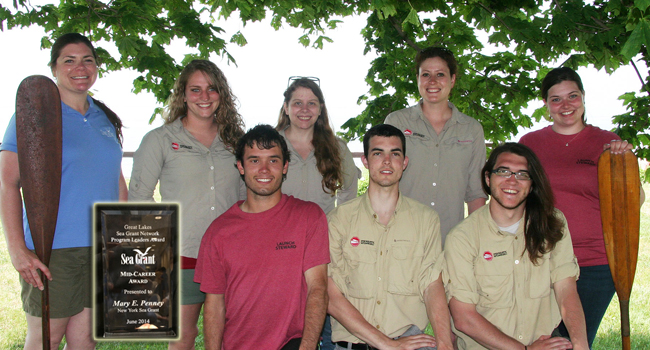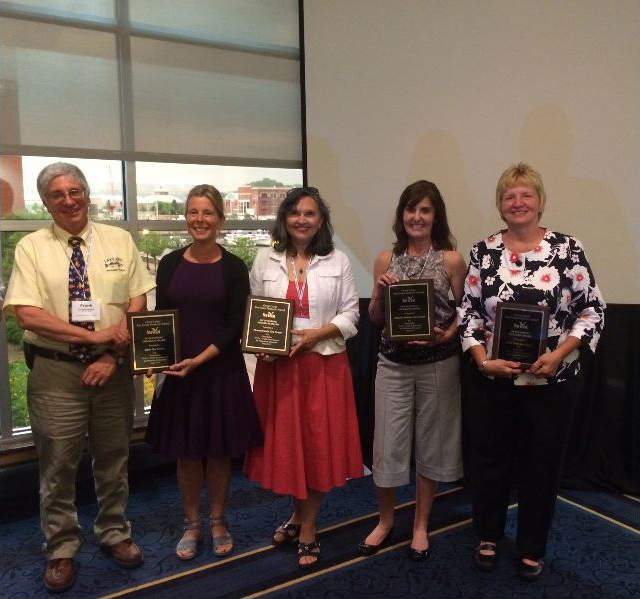Local Media Take Note of Sea Grant-ers Assembled in Erie, PA for Regional Talks
Contacts:
Mary Penney, Coastal Community Development Specialist, New York Sea Grant, SUNY Oswego, E: mp357@cornell.edu, P: 315-312-3042
Helen Domske, Coastal Education Specialist, New York Sea Grant, University at Buffalo, E: hmd4@cornell.edu, P: 716-645-3610
Katherine Bunting-Howarth, Associate Director, New York Sea Grant, E: keb264@cornell.edu, P: 607-255-2832
Ithaca, NY, June 18, 2014 – The New York Sea Grant Extension Office at Cornell University in Ithaca, NY has announced that two of its Great Lakes program educators have been honored for excellence by the Great Lakes Sea Grant Network.
The network of Sea Grant programs in the nine Great Lakes states –
Wisconsin, Michigan, Minnesota, Illinois, Indiana, Ohio, Vermont,
Pennsylvania and New York – gave out the awards yesterday (June 17) at its 2014 Great Lakes
Sea Grant Network conference in Erie, PA.

New York Sea Grant Coastal Community Development Specialist Mary Penney (pictured above with 2013's Launch Stewards) has received the 2014 Great Lakes Sea Grant Network Mid-Career Award.
Some of Penney's recent achievements can be found via the following related news items: "NYSG and SUNY Oswego Launch Business Retention and Expansion Pilot Program in Oswego County" and "On YouTube: Sea Grant's Launch Stewards and Related Programs Help Prevent Invasive Species' Spread."

New York Sea Grant Coastal Education Specialist Helen Domske (pictured above, far right) was presented the 2014 Great Lakes Outstanding Outreach Programming Award with several colleagues for programming that provides teachers with field experiences to improve watershed education in the classroom. Domske and her colleagues were presented the award at last night's banquet by Ohio Sea Grant extension specialist Frank Lichtkoppler (pictured above, far left). Others awarded in this project include (l-r): Marti Martz, Senior Coastal Outreach Specialist, and Anna McCartney, Communication/Education Specialist, at Pennsylvania Sea Grant; Terri Hallesy, Education Coordinator, and Robin Goettel, Associate Director for Education (retired; not pictured), at Illinois-Indiana Sea Grant.
For more information on this collaborative effort, see NYSG's related news item, "Teaching the Teachers Via NOAA BWET: Lake Ontario Lessons."
More on NYSG's Mary Penney
“In just eight years of service with New York Sea Grant, Mary Penney has
applied a community-driven needs assessment approach to identify and
respond to the priority issues of decision-makers in the Eastern Lake
Ontario region and its inland water areas including the Salmon River,”
says New York Sea Grant Associate Director Katherine Bunting-Howarth, based at Cornell University, Ithaca, NY.
As New York Sea Grant Coastal Community Development Specialist, Penney assists local leaders interested in land use planning, watershed protection, managing climate impact, coastal business retention and development, and developing stewardship volunteerism. She often facilitates multi-interest stakeholder communication forums to promote sustainable coastal community development.
Penney, based at SUNY Oswego in Oswego, NY, has developed science-based fact sheets and packaged traveling education trunks for use by school districts throughout the Eastern Lake Ontario region.
Penney has trained young professionals to be stewards for the Lake Ontario dunes– Salmon River system, and as watercraft inspection stewards educating the public in seven Central New York counties about how boaters can help slow the spread of aquatic invasive species in New York’s recreational waters. She is currently completing development of the New York State Watercraft Inspection Steward Program Handbook.
More on NYSG's Helen Domske
Working with educators from the Sea Grant programs in Ohio, Pennsylvania, and Illinois-Indiana, New York Sea Grant Coastal Education Specialist Helen Domske provides professional development training that equips K-12 grade-level teachers to actively engage thousands of students in Great Lakes environmental stewardship.
Domske is a respected and award-winning proponent of Great Lakes literacy training. Her teach-the-teachers approach extends science-based learning and activities to support curricula development focused on Great Lakes and New York resources.
The following efforts are among the results inspired by Domske’s programming in 2014:
- 10 student-led beach or stream cleanups in Western NY
- Student-developed informational materials on the proper disposal of unwanted pharmaceuticals and personal care products
- 100 Oswego County students interacted with biologists at the New York State Salmon River Fish Hatchery
- Oswego high school students participated in an invasive species mapping project at a local field station
- Students upgraded Sandy Bottom Park and a boardwalk on Honeoye Lake and built and installed wood duck nesting and bat boxes with educational signing,
- Williamsville High School students created a Leaders for Environmental Awareness and Protection (LEAP) Club.
“The Great Lakes Sea Grant Network Outstanding Outreach Programming Award recognizes success built on exceptional leadership and teamwork that creates significant effect on the Great Lakes environment – that describes the impact of New York Sea Grant Coastal Education Specialist Helen Domske’s programming every year,” says Bunting-Howarth.
On YouTube: Local Media Takes Note of Sea Grant-ers Assembled in Erie, PA
Regional Discussions on Invasive Species, Harmful Algal Blooms and More
Erie, PA, June 16, 2014 – As seen in this clip from WICU-TV (a Erie, PA NBC-affiliate station) and WSEE-TV (a Erie, PA CBS-affiliate station), some 85 representatives from around the Great Lakes are networking in Erie this week, as part of the Great Lakes Sea Grant network conference. The group has meetings like this about every 18 months around the basin of the lakes.
It's a chance to collaborate face to face on common issues of concern around the great lakes in both the U.S. and Canada. The representatives are talking about maintaining water quality for people and aquatic life. They're sharing data from observation systems around the lakes, including the new weather buoy recently deployed off Erie.
The Sea Grant conference is also sharing the latest information on the harmful algae blooms that cropped up around the lakes last year. "This is about the time we saw that last year," said Marti Martz, Sr. Coastal Outreach Specialist with Pennsylvania Sea Grant's office at the Tom Ridge Environmental Center. "June 26 we had the first reports of that last year, but this year we're far more ready, we've developed protocols for monitoring and testing so we're much more ready for it this year," Martz added. Lake Erie is especially susceptible because it is shallow and because of the run off of nutrients from farms.
"This is an issue that effects all the Great Lakes and it has fairly
serious implications for human and animal health as well as coastal
economies," say New York Sea Grant Fisheries Specialist Dave MacNeill, who hosted several harmful algal bloom workshops over the last year, including one with Pennsylvania Sea Grant. For more on that, see NYSG's news item "On YouTube, On Blog: NYSG Harmful Algal Bloom Workshops a Model for Helping Great Lakes Stakeholders."
Attendees are also sharing information on how to keep boaters from moving aquatic invasive species from lake to lake or to inland waterways. The big concerns are zebra and quagga mussels, round gobies, spiny water fleas and the much discussed Asian Carp.
Sarah Whitney, Associate Director of the Susquehanna River PA Sea Grant Office said there are steps boaters can take to help. "The big key pieces are to check drain and dry. Check around your boat and trailer for any clumps of organic material you may be carrying, drain bilge water, buckets...we want to keep any water where it is. And drying your equipment up to five days, that will prevent species from being moved from one location to another," said Whitney.
"Three things I like to remind people about are: having the right type of life jacket, the right number – one for everyone on board – and the right size, whether it be an adult, child or pet, such as a dog,” added Dave White, senior extension associate with New York Sea Grant Extension and NYSG's coastal recreation and tourism specialist. White is also the campaign developer for the “Discover Clean & Safe Boating” project, which is detailed in NYSG's news item, "On YouTube, On Air: Sea Grant Partners to Discover a Bigger, Better Boating Education Program."
In addition to extension specialists and funded researchers, Sea Grant also has a national network of Communications specialists, a number of whom are in attendance from throughout the Great Lakes Sea Grant programs.
"A big part of our convening as a region here in Erie is to discuss ways that we might more effectively communicate coastal science to the greater public," said New York Sea Grant's Web Content Manager Paul C. Focazio. He cited that target audiences include anglers and boaters as well as legislators and partners, especially those higher up the chain of the National Oceanic and Atmospheric Administration, Sea Grant's parent organization.
"So, while we're discussing our efforts related to everything from this year's hurricane outlook to harmful algal blooms in Lakes Erie and Ontario, we're making a point to identify which platforms might be the best ways to spread the word. We're finding sometimes that's via social media, apps and Web sites and other times through more traditional avenues, such as radio, television and, yes, the printed word."
The Sea Grant folks will be in town through Wednesday.
More Info: New York Sea Grant
New York Sea Grant (NYSG), a cooperative program of Cornell University
and the State University of New York, is one of 33 university-based
programs under the National Sea Grant College Program (NSGCP) of the
National Oceanic and Atmospheric Administration (NOAA). The NSGCP
engages this network of the nation’s top universities in conducting
scientific research, education, training and extension projects designed
to foster science-based decisions about the use and conservation of our
aquatic resources. Through its statewide network of integrated
services, NYSG has been promoting coastal vitality, environmental
sustainability, and citizen awareness about the State’s marine and Great
Lakes resources since 1971.
For updates on Sea Grant activities: www.nyseagrant.org has RSS, Facebook, Twitter, and YouTube links. NYSG also offers a free e-list sign up via www.nyseagrant.org/coastlines for NY Coastlines, its flagship publication, which, in 2014, merges with the program's e-newsletter, Currents. NY Coastlines is published several times a year.